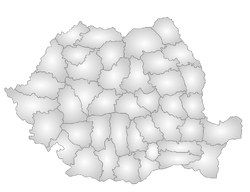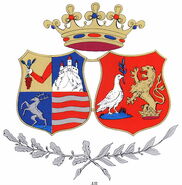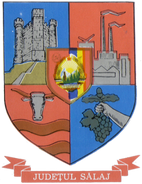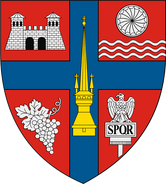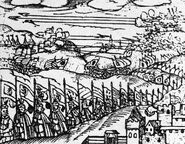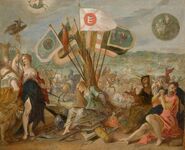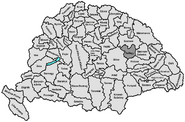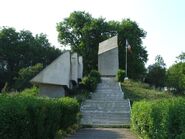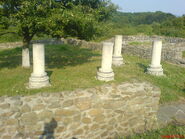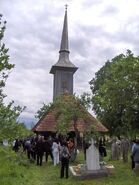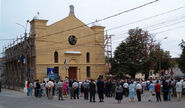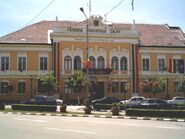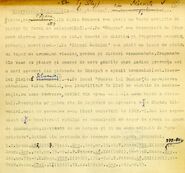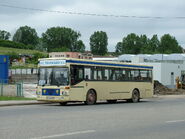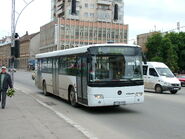| Main | Births etc |
|---|
| ||||||||||||||
| Sălaj County Județul Sălaj |
|||
|---|---|---|---|
| — County — | |||
|
|||
| Country | Romania | ||
| Development region | Nord-Vest | ||
| Historical region | Crișana, Transylvania | ||
| Capital | Zalău | ||
| Area | |||
| • Total | 3,864 km2 (1,492 sq mi) | ||
| Area rank | 38th | ||
| Population (2011) | |||
| • Total | 224,384 | ||
| • Rank | 39th | ||
| • Density | 58/km2 (150/sq mi) | ||
| Telephone code | (+40) 260 or (+40) 360[1] | ||
| ISO 3166 code | RO-SJ | ||
| Website | County Council Prefecture |
||
Sălaj (Romanian pronunciation: [səˈlaʒ], Hungarian: Szilágy) is a county (judeţ) of Romania, in the historical regions of Crişana and Transylvania, with the capital city at Zalău.
Geography[]

Sălaj County Map
Sălaj county has a total area of 3,864.38 square kilometres (1,492.05 sq mi).
It lies in the area between the Apuseni Mountains and the Eastern Carpathians known as the Someş River Platform. The county is crossed by the Someş River. Some of the smaller rivers who flow through the county are: Crasna River, Barcău, Almaş, Agrij and Sălaj.
From a geographical point of view Salaj county is a zone of hills and depressions along the rivers Almaş, Agrij, Someş River, Sălaj, Crasna River and Barcău River. The mountains are represented in the south-west by two northern ramifications of the Eastern Carpathians: the Meses and Plopis peaks. Depressions cover an important part of the county’s territory and are important agricultural zones with numerous human settlements.
Neighbours[]
Sălaj county borders on Satu Mare and Maramures counties to the North, Bihor county to the West and South-West and Cluj county to the South-West.
- Bihor County to the west.
- Maramureş County and Satu Mare County to the north.
- Cluj County to the south and east.
Climate[]
As for climate, Salaj county is under the influence of masses of air coming from West having a moderate continental climate. The average annual temperature varies between 6°C and 9°C, depending on the zone while the highest temperature, in July, varies between 15°C and 20°C. Rainfalls quantitatively decrease towards the west where 700-800 ml/sq.m were recorded.
Demographics[]
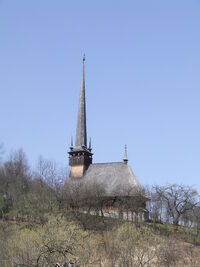
Wooden Church of Fildu de Sus was built in 1727
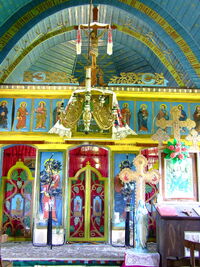
Interior from wooden church of Poiana Onţii, Sălaj County
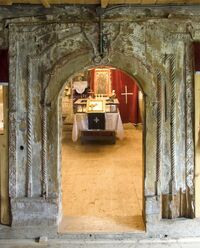
The entry of Sârbi wooden church
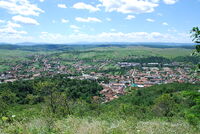
Șimleu Silvaniei City
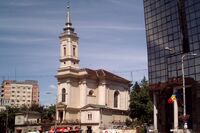
Zalău City Downtown
In 2002, it had a population of 248,015 and the population density was 64/km². Majority of the population lived in rural area (60,3%) and 39,7% lived in four cities: Zalău, Șimleu Silvaniei, Jibou, and Cehu Silvaniei.
- Romanians - 71.6%[2]
- Hungarians - 23%
- Gypsies - 5%
- Slovaks - 0.5%
- Other or undeclared ethnicity - 0.1%
| Date | Year | County population[3] |
|---|---|---|
| 1880 | 159,872 | |
| 1890 | 180,145 | |
| 1900 | 193,996 | |
| 1910 | 230,140 | |
| December 29 | 1930 | 343.347 |
| January 25 | 1948 | 262,580 |
| February 21 | 1956 | 271,989 |
| March 15 | 1966 | 263,103 |
| January 5 | 1977 | 264,569 |
| 1989 | 268,776 | |
| January 1 | 1990 | 269,962 |
| January 1 | 1991 | 269,963 |
| January 1 | 1992 | 266,837 |
| January 7 | 1992 | 266,797 |
| January 1 | 1993 | 266,181 |
| January 1 | 1994 | 264,990 |
| January 1 | 1995 | 263,228 |
| 1995 | 262,873 | |
| January 1 | 1996 | 262,143 |
| January 1 | 1997 | 260,413 |
| January 1 | 1998 | 258,717 |
| January 1 | 1999 | 257,718 |
| January 1 | 2000 | 256,177 |
| January 1 | 2001 | 255,535 |
| January 1 | 2002 | 250,517 |
| March 18 | 2002 | 248,015 |
| January 1 | 2003 | 249,717 |
| 2003 | 249,194 | |
| January 1 | 2004 | 248,857 |
| January 1 | 2005 | 246,209 |
| 2005 | 245,638 | |
| January 1 | 2006 | 246,413 |
| July 1 | 2006 | 244,952 |
| January 1 | 2007 | 243,614 |
| July 1 | 2007 | 243,157 |
| January 1 | 2008 | 242,854 |
In 1910, county had a population of 230,140 people. Population by language:
- Romanian = 136,087
- Hungarian = 87,312
- Slovak = 3,727
According to 1930 census, the county had a population of 343.347 people, of which 56,2% Romanians, 31,4% Hungarians, 4,7% Germans, 3,9% Jews ş.a; after confesional criteria: 52,6% Greek Catholics, 25,4% Protestants, 12,2% Roman Catholics, 4,0% Jews, 4,4% Orthodox.
On July 1, 1995, the county had a population of 262,873 inhabitants of which 70,932 in Zalău.
In 2005, Sălaj county has 245,638 inhabitants (120,278 men and 125,360 women). According to INSSE, on July 1, 2007, the population of Sălaj county was 243,157 inhabitants, of which 99,353 urban population and 143,804 rural population.
Tourism[]
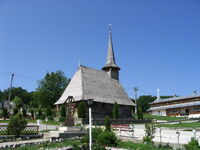
Wooden church of Stâna built in 1778, transferred to Bic Monastery in 1997
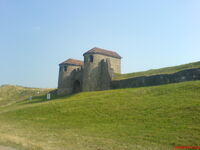
The reconstructed gateway of the castrum in Porolissum
The 77 wooden churches (16th-19th century) place this county among the first ones, with the Maramures county, as a such valuable historic and folk architectural monuments.
The main tourist attractions in the county are:
- Museums in Zalău and Şimleu Silvaniei
- Wooden churches in Fildu de Sus, Sânmihaiu Almaşului, Baica, Racâş
- Báthory Castle in Şimleu Silvaniei
- Báthory mansion (16th century) in Şimleu Silvaniei
- Roman Catholic church (1532) in Şimleu Silvaniei
- Northern Transylvania Holocaust Memorial Museum (Romania's first Holocaust Memorial Museum) in Şimleu Silvaniei
- Wesselényi Castle in Jibou
- Botanical Gardens in Jibou
- Spa baths in Jibou
- Jewish Cemetery in Cehu Silvaniei
- Memorial house and tomb of Simion Bărnuţiu in Bocşa
- Porolissum (ancient Roman city)
- Ioan Sima Art Gallery
- Zmeilor Garden are conglomerates of sands uniqe in Europe at Gâlgău-Almaşului
- Over 350 historical monuments
Economy[]
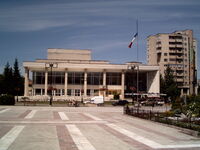
The main square in Zalău
The predominant industries in the county are:
- Machine and automotive components
- Food
- Textiles
- Wood, furniture and paper
History[]
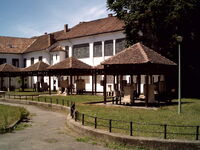
Roman relics displayed at Zalău
Paintings dating back 12,000 years were discovered on the walls of a cave in Cuciulat, a settlement on the banks of the Someş River. They are the oldest paintings of the kind in this part of Europe. The oldest solid gold treasury ever unearthed in Romania, weighing 780 gr. and belonging to the Neolithic, was found in Sălaj at Moigrad.
Lying in the north-western part of Romania, at the crossing between the Western and Eastern Carpathians, Sălaj county has been known since ancient times as Tara Silvaniei, that is the Land of the Forests. Zalău was known as a market town as early as the 14th century and mentioned in a document as a town in 1473.
Under Austria Hungary[]
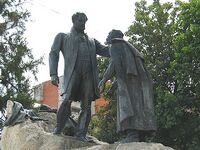
Statue of Miklós Wesselényi built in 1902 in Zalău by János Fadrusz
Sălaj County (Hungarian: Szilágy) was formed in 1876, when the counties Kraszna (its center was Valkóváralja at first, later Szilágysomlyó) and Közép-Szolnok (Its center was Zilah) were united. Its territory is for a large part the same as that of the present Romanian county Sălaj County. Its area was 3815 km² around 1910. The capital of the county was Zilah (present-day Zalău in Romania).
In 1918 (confirmed by the Treaty of Trianon 1920), the county became part of Romania. It was occupied by Hungary between 1940-1944 during World War II. Most of it is now part of the Romanian county Sălaj County, except some areas in the north-west (presently in Satu Mare county) and north-east (presently in Maramureş county).
During the Kingdom of Romania, Sălaj County was divided in 8 plăşi (Plasa Carei, Plasa Cehu Silvaniei, Plasa Crasna, Plasa Jibou, Plasa Şimleu Silvaniei, Plasa Tăşnad, Plasa Valea lui Mihai and Plasa Zălau.
Politics[]
2008 elections[]

May 2008 electoral campaign in Zalău
The Sălaj County Council, elected in the 2008 local government elections, with the following party composition:
| Party | Seats | 2008 Sălaj Council | ||||||||||
|---|---|---|---|---|---|---|---|---|---|---|---|---|
| Democratic Union of Hungarians in Romania | 8 | |||||||||||
| Social Democratic Party | 8 | |||||||||||
| National Liberal Party | 6 | |||||||||||
| Democratic Liberal Party | 6 | |||||||||||
2004 elections[]
The Sălaj County Council, elected in the 2004 local government elections, with the following party composition:
| Party | Seats | 2004 Sălaj Council | ||||||||||
|---|---|---|---|---|---|---|---|---|---|---|---|---|
| Democratic Union of Hungarians in Romania | 8 | |||||||||||
| Social Democratic Party | 7 | |||||||||||
| National Liberal Party | 8 | |||||||||||
| Democratic Liberal Party | 7 | |||||||||||
| Greater Romania Party | 1 | |||||||||||
Notable residents[]
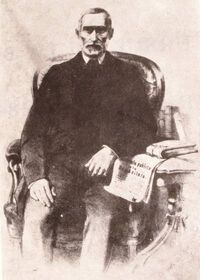
Simion Bărnuţiu was a famous Transylvanian, born in Bocşa, Sălaj
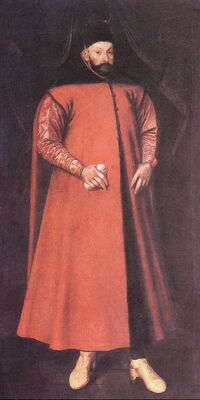
King of Poland between 1576-1586, Stephen Báthory of Poland was born in Sălaj County
- Alexander Ratiu
- Stephen V Báthory,
- Simion Bărnuţiu,
- Augustin Deac,
- Miklós Wesselényi,
- Îndreiu, priest in Giurtelecu Şimleului in the first half of 17th century, one of oldest hand bookbinders of Transylvania
- Iuliu Maniu,
- Petri Mór,
- Ioan Lobonţiu was a priest and dean (protopop) in Giurtelecu Şimleului in the 19th century and 1848 revolutionary. On March 19, 1848 the dean Lobonţiu presided in Giurtelecu Şimleului the first meeting of the Revolution of 1848 in Transylvania and announced the emancipation of serfs.
- Endre Ady,
- Béla Kun,
- Corneliu Coposu,
- Ioan Taloş, deputy of the Electoral circle of the Şimleu in the National Assembly and priest in Giurtelecul Şimleului in the first half of the 20th century.
- Joe Pasternak,
- Alexandru Dragomir
- Danil Graur or Daniel, teacher in Giurtelecul Şimleului, newspapers editor, and the inspector of the schools in Sălaj County (1918–1919).
- Emil Pop
- Alexandru Papiu Ilarian,
- Iuliu Coroianu,
- Grigore Lăpuşanu
- Alexandru Koller
- George Pop de Băseşti
- Iulian Andrei Domşa, prefect of Sălaj County and mayor in Zalău in the 20th century
- Alimpiu Barboloviciu
Administrative divisions[]
Sălaj County has 1 municipality, 3 towns and 58 communes; subdivided into 281 villages
- Municipalities
- Zalău - capital city; population: 64,123 (July 1, 2006), 63,860 (January 1, 2008)
- Towns
- Cehu Silvaniei - population: 8,199 (July 1, 2006)
- Jibou - population: 11,457 (July 1, 2006)
- Șimleu Silvaniei - population: 16,325 (July 1, 2006)
Villages[]
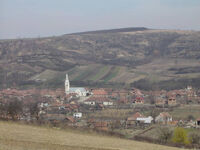
Borla, Sălaj
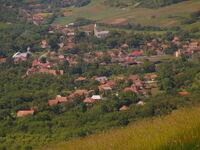
Treznea
- Borla, Sălaj
- Giurtelecu Şimleului
- Jac
Works[]
- Petri Mór, Szilágy vármegye monographiája [Sălaj County Monography] (I-VI, Budapest, 1901–1904).
- János Kovács Kuruc, Zilah vallási életéről, In: Limes, 2000, 3, nr. 1-2, p. 138-143.
- Éva Lakóné Hegyi; Wagner, Ernő. A zilahi kalandosok, In: EM, 2001, 63, nr. 1-2, p. 30-41.
- Florin Mirghesiu, Modernitatea Zalăului. In: AMPZ, 2001, 2, nr. 4, p. 11-19.
- Moroti, Elisabeta. Scurtă privire istorică asupra dezvoltării economice a oraşului Zalău, In: AMPZ, 2001, 2, nr. 4, p. 36-39.
- Municipiul Zalău. Prezentare. In: AMPZ, 2002, 3, nr. 7-8, p. 154-161.
- Elena Muscă, Meşteşugari zălăuani şi locul lor în structurile administraţiei publice locale, In: AMP, 2003, 25, p. 325-332.
- L. Nicoară; Puşcaş, Angelica. Rolul municipiului Zalău în zona de contact dintre depresiunea Transilvaniei şi Dealurile de Vest, In: Studia geogr., 1999, 44, nr. 1, p. 99-112.
References[]
- ^ The number used depends on the numbering system employed by the phone companies on the market.
- ^ National Institute of Statistics, "Populaţia după etnie"
- ^ National Institute of Statistics, "Populaţia la recensămintele din anii 1948, 1956, 1966, 1977, 1992 şi 2002"
External links[]
- (Romanian) http://www.cjsj.ro/index.php
- (Romanian) http://www.salaj.insse.ro/main.php
- (Romanian) and (English) http://www.insse.ro/cms/files/pdf/ro/cap2.pdf
- (English) http://circa.europa.eu/irc/dsis/regportraits/info/data/ro066_geo.htm
- (Romanian) http://www.flickr.com/photos/mipepitoida/2869382695/
Gallery[]
| |||||||||||||
| |||||||
| This page uses content from the English language Wikipedia. The original content was at Sălaj County. The list of authors can be seen in the page history. As with this Familypedia wiki, the content of Wikipedia is available under the Creative Commons License. |



